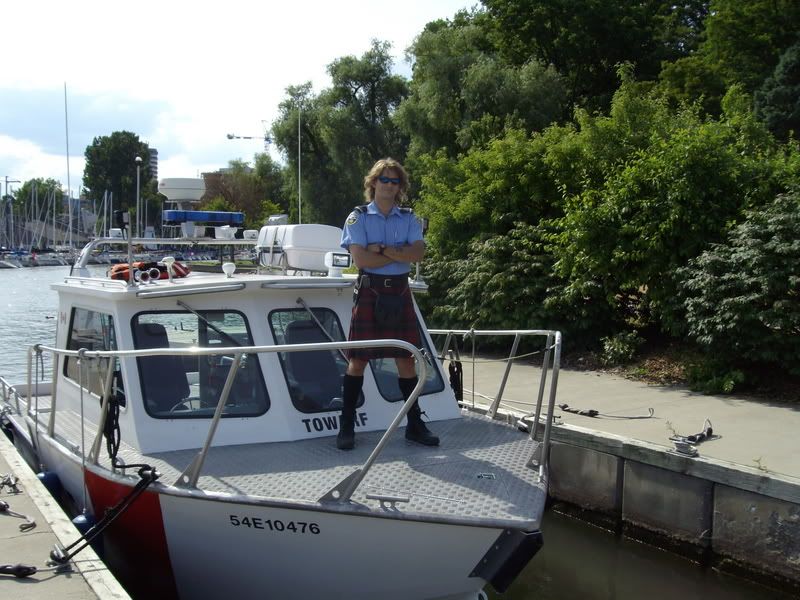 |
| The newish Vesper Vision: All that and a bag of navigational chips? |
Behold the
Vesper Watchmate Vision, the latest iteration of a standalone AIS transponder from my (to date) favourite AIS maker, at least in the small boat realm. I'm tempted, not particularly with the touch-screen aspects, as I am at home with buttons and drop-down menus, but with the implementation of various display schemes (
as decently reviewed by Ben Ellison here at PANBO; don't neglect to read the unusually erudite comments section), but due to its interesting connectivity options, which include USB and...oh, joy!...Wi-Fi.
Now, the more alert of my readers may point out that my steel boat's
a friggin' Faraday cage and not likely to do well with Wi-Fi. In a sense, that's true, but if the PC is on one side of the pilothouse (right by the map chest, as per standard belt and suspenders nautical practice), and the AIS is only a couple of metres away, Wi-Fi means "one less wire to run", which has its charms in the modern age of sailing. I'm not sure who thought making an AIS a hotspot was a good idea, but if one is leaning toward a
PC plotter solution over
a proprietary multi-function display, it has a lot of potential. I don't really need wireless on the deck. In the boat could be useful.
 |
| ICOM's transponder offering has been described to me as solid and well-integrated with their top-end M-604 VHF base station. |
Now, Vesper's just the AIS brand I currently prefer, but there are other, equally capable players in the AIS market. ICOM's a brand I generally respect (and have purchased in the form of VHF base units and our M-802 SSB). Their
MA-500 seems graphically basic, but shoots the same data to a plotter that resolves as pretty little triangles in colours that show intentions, like I Am Going to Mow You Down Soon. You know, the
useful stuff.
 |
| The Vesper Watchmate 850, the one I've considered best-in-class since its introduction. |
The really useful stuff when it comes to AIS, however, seems to be about the ability of the unit's software to filter out non-relevant data, particularly in large commercial harbours or in busy shipping lanes. This filtering means you don't see traffic that won't pass closely, and the alarms can be tailored to truly close encounters. The
problem with the otherwise
Extremely Useful AIS function seems to relate in the issue of filtering the clutter, and the
possibility that the "recreational rated" Class B units (more on this shortly)
won't be seen. I personally think that
half the function of AIS is being seen positively as another ship in fog
when temperature inversions, waves or range issues render a radar
presence intermittent. So "being seen" is sort of the point.
 |
| Another approach: a package deal of "black box below" and display at the helm, or even at the outside helm. |
I
consider AIS a great adjunct to RADAR, and a huge help when crossing
shipping lanes, primarily because you can call the bridges of big
fellows by ship name and using DSC and their MMSI number. This doesn't
mean they can see you on radar or on their AIS. As I present on our steel
hulk the radar profile of a small lightship, I'm not so worried, but a
plastic boat can be invisible until uncomfortably close. I was considering, based on my research, a Class B unit called a Vesper AIS Watchmate 850: I may still, except that Vision model has some additional bells and whistles I would like to try. The 850, which I've had a chance to molest in person, remains quite intuitive
and seems to look forward to the time when every buoy, pier end and
jetski will have an AIS transceiver, which, as is the way of all good things,
will kill the system. There
are already signs of
too much Class B traffic rendering full coverage problematic.
But perhaps, for the uninitiated, a somewhat deeper look at the Universal Shipborne Automatic Identification System is in order. I found that the first order of business was to grasp
the difference between Class A and B AIS units. The link provided is one firm's slide show giving a medium-complexity overview of how the two classes differ.
Personally, I think that Class A would make sense were we crossing the Channel to France once a week because of its increased (12 watts) power and more rapid "refresh rate" (I'm trying to avoid the actual explanation here, which is thick with acronyms and is freely available). It's more "shippy" in the sense that while a sub-300 tonne ship doesn't require it (and it's about three times the price), your boat will, in terms of AIS, resemble commercial, rather than recreational traffic.
By contrast, a Class B (2 watts) transponder would seem to fit the bill. There's a good reason
not to look like a Class A-equipped ship to the real deal. You will be actively avoided as the sluggardly unprofessional navigational hazard you are, and, by implication, all sail-driven craft are when you are looking down on them from the bridge of a vessel with five figures in its horsepower rating.
Another part of the rationale for us in opting for Class B is due to the rather simple fact that our boat is metal and returns a fat radar signal; I am also sensitive to the power draw of 12 versus 2 watts; a third is that AIS seems quite sensitive to antenna placement and general radio concepts,
such as a pre-amp on the splitter, which can give a boat, either as a "receive-only" or as a target, a useful range exceeding line-of-sight from the deck,
and occasionally a great deal further.
 |
| Many would opt for a solution that uses one antenna at the mast top for both VHF and AIS, which work in similar frequency ranges. Other opt for a "dedicated" AIS antenna that is sized more precisely for its frequency either side of 162 Mhz. |
Speaking of distance, there is more than one school of thought about "receiver versus transponder" when it comes to AIS. A
recent thread on Cruisers' Forum found the ability of AIS to advertise one's boat's location "creepy" for reasons of security. Well, so does a pair of binoculars on a sunny day, I suppose, but before one visualizes an admiral's hat made out of tinfoil, it would be foolish to acknowledge that a transmitting sailboat is both safer from potential collisions (and provides a "last reported position to SAR folk if you hit a rock) and a nice way for a thief to see you arriving with a
cheap iPhone AIS app. Or
even on Google Earth...how convenient!
I won't even stoke the paranoia concerning how AIS can be seen only 20 or so miles around one's boat...
but can be registered by properly equipped satellites. And, no doubt, the famous black helicopters of the Nazi space lizard secret government...
 |
| Aye, aye, Skipper. |
But there is a solution:
turn off the transmitter. Now you can only be seen by eye, by a nifty pocket telescope, by RADAR, by VHF if you announce yourself, and by cellphone if you are close enough to shore and haven't turned the damn thing off! It behooves the truly suspicious here to recall that cellphones can be loaded with "
snooper apps" invisible to the
user that report via internal
GPS
or proximity to cell towers the phone's location...so if you get snatched by marine kidnappers because you have a paranoid spouse, don't blame me. The cops or the Coast Guard of probably every country on Earth can narrow your location down via your cell phone even without such apps through
the magic of triangulation. AIS is no different in terms of "hey, world, look at me!"...except that you
can turn off the transmitter and go "black", at least in terms of broadcasting your lat/lon, your MMSI and boat name, et cetera.
I am under the impression that
most commercial vessels were obliged by regulation to transmit on AIS, (although not most military, as far as I can discern, but they aren't shy about telling you if you are crowding them in your little boat). Would I therefore stay transmitting while coastal cruising? Yes, if I was solo (because it's
like a
SPOT tracker to rescuers if I fall off the boat and forget to
bring my bag of breadcrumbs), but "not necessarily", were we well crewed, as there is
no compelling reason to announce our presence to other boats or ships
on, say, a clear, sunny day. The presence of AIS does not excuse us from keeping a
proper watch by eye, or by eye and RADAR if that's part of the nav tools
available. So one gains a measure of privacy in a rather tightly defined sense if one ceases to transmit as an AIS target. I define the worth of that privacy in light of my belief that a) AIS is more useful to allow the little boat to be seen by the ship capable of cutting it in half, and b) if everyone went "receive-only", the utility of the system to see anything below 500 tons would be compromised.
At night, circumstances change. In
fog, at night, AIS is probably better than RADAR if one has a fibreglass boat, because it transmits (usually) from the
mast top, and the typical plastic
hull behind a series of waves can make a poor target for a ship's radar. I recently read of
a yacht crossing of the busy Channel in fog made non-eventual thanks to AIS.
It argues that one's visibility to commercial and other large moving objects trumps the perhaps overcooked issue of privacy...unless one is, perhaps, a smuggler of forbidden cheese.
Offshore, heck yes: I
want to be seen as well as to see, and AIS is frequently better
than RADAR for picking up ships barely at the horizon...as
seen from 50 feet up! The earlier the hypothetical 20-knot container ship can
plot our CPA, the smaller the helm correction required to give us (
or we to give them, as per COLREGS) a wide and safe berth. Two ships that pass in the night doesn't, in fact, just happen.
Offshore entering the Red Sea or
certain historically yacht-hostile straits near Indonesia, or
perhaps the Gulf of Guinea? We would, assuming we felt a compelling need to transit dodgy waters, likely go "radio silent", which would include AIS. We would also consider dousing nav lights and whispering, as well, but would place doubled eyeballs on
deck watch duty. Seriously, however, for us to find ourselves in such a situation would have to be due to a rare case of a pirate or drug-running criminal outbreak in a place not known for it. If we were travelling in convoy and were being monitored on a pre-arranged basis by various friendlies with large boomsticks, we would go full Christmas tree. We would want to be seen being seen, so to speak.
So the solution to the "creepy privacy issue" of AIS is to figure out if one's kind of sailing is enhanced by
being seen, and then to find the OFF button if the answer is, "yes, but
not all the time". Frankly, less clutter is better:
who really needs to know you are docked? If you are using your iThing in your tender to find your over-illuminated boat via GPS and AIS tracking...you
may be over-equipped for the voyage.
I have come to believe through my researches (which seem to inevitably lead to purchases) that RADAR and AIS represent a Venn diagram of watchkeeping at a distance.
The reason to install a RADAR is to see where the rocks, reefs, unlit fisherfolk and beaches are, presumably to avoid them. AIS catches
either ships and AIS-transmitting objects too far for RADAR (or the RADAR operator, because reading RADAR is a learned skill) to discern, or it helps
to sort a bunch of blobs with names and real-time position tracking not
calculated on your boat, but from the transmitting boat. Yes, I'm aware of
MARPA, but one windy post at a time! The budget-minded can buy one of the newer AIS units and the cheapest sort of basic radar and have
more comprehensive watchkeeping than one would have with a
commercial radar of the latest tech alone.
 |
| Angry Birds and Invisible Jetskis: finally together in one device. |
There's an added wrinkle, I'm afraid, and the reason for my mention of "moving targets" in this post's title: the introduction of a
new class of AIS to be used on smartphones. It's
still pretty new, but the "pocket plotter" is clearly a thing to be reckoned with. The utility of centralizing all one's navigational aids on a single smartphone, of course, remains to be tested. Not ideal if I'm not sporting pockets, is it?
 |
| You want to be careful fishing around in that sporran, laddie. (c) 2007 "The Grant" |
AIS can be complex or as basic as one wishes. My understanding of it seems to match
what sailors I respect are saying, and even if it remains a somewhat evolutionary technology, the advantages to having it aboard seem to me to be increasingly well-established if one wishes to transit the several areas of the world where commercial shipping is even remotely concentrated.
























